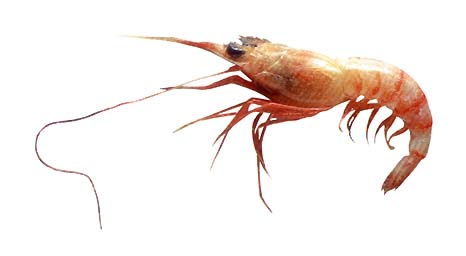クダヒゲエビ科

- HOME
- デジタル図鑑
- スリナム・ギアナ沖の甲殻類および軟体類
- 十脚目 長尾亜目
- クダヒゲエビ科
クダヒゲエビ科(Solenoceridae)

ヒメクダヒゲエビ
Solenocera atlantidis Burkenroad, 1939
特 徴:
体長6cm。小形種。頭胸甲はやや側扁し,頸溝より前方に短毛がある。頸溝は強く,背縁で左右が連続している。その前方は肝上棘の前部で,ほぼ水平な肝溝と合し,そのまま前側角棘へ向かう。眼窩後棘は前方を向き,眼窩上棘および触角上棘は小さい。額角は頸溝より前方に刀状に発達し,側面に短毛がある。先端は角膜中央部に達するのが一般的である。上縁には胃上棘を含めて4〜7歯あり,多くは6歯である。下縁には長毛の縁取りがある。頸溝から後方に正中隆起はない。第3〜6腹節に正中隆起があるが,第4節以後では鋭い稜を形成する。
採集記録:
水深33〜91m(24 exs)。
分 布:
アメリカ・ノースカロライナ州沖からメキシコ湾,カリブ海沿岸を経てブラジル南部まで。水深18〜223m。ほとんどは75m以浅。
備 考:
ごく近縁のヒメクダヒゲエビモドキS. geijskesi Holthuisも今回の調査で相当数採集されたが(北緯5度13分,西経51度30分,水深66m),標本の保存状態が悪く,カラー写真に記録することができなかった。慣れないと区別しにくいが,額角が角膜末端をやや越え,上縁に7〜8歯ある。また,第1触角基部の棘状突起が明らかに長い。カリブ海からブラジルまでの水深18〜70mに分布。
Diagnostic characters:
A small species having no dorsal carina behind cervical groove. Cervical groove very strong, meeting anteriorly with transverse hepatic groove and running toward branchiostegal spine. Postorbital spine directed anteriorly; orbital and antennal spines small. Rostrum well developed so as to be a blade, its tip ending at a level of median part of cornea; upper margin with four to seven teeth, (usually six), and lower margin fringed with long soft hairs. Third to sixth abdominal segments with a dorsal carina.
Distribution:
West Atlantic from North Carolina through the Gulf of Mexico and the Caribbean Sea to southern Brazil, 18-223 m deep.
Remarks:
More than 50 specimens referable to S. geijskesi Holthuis, 1959, were collected at a station of 5°13′N, 51°30′W, 66 m deep, but they were unfortunately not preserved in good condition to produce the color photographs. It ranging from the Caribbean Sea to Brazil is distinguished from this species, in addition to the differences in the form of therycum and petasma, by having the longer rostrum (extending to level of tip of cornea) with seven or eight teeth on upper margin.